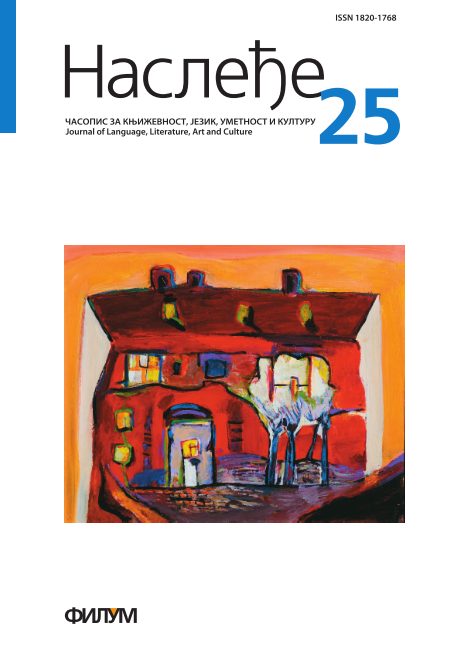PRESENTATION AND SELF-PRESENTATION OF JEWS IN EARLY MODERN EUROPEAN HISTORY
Keywords:
Renaissance visual culture, iconography of anti-Semitism, Judenbild, changing stereotypes of sacred and profane art, visualization of the Old Testament heroes, Jewish art and self-presentationAbstract
Renaissance visual culture, sacred and profane, has shaped the character of the Jew as a grotesque and corrupt. However, the development and duration of this stereotype was not linear, but has changed within the changing context of Christian-Jewish relations. Although the imagery Adversus Judaeos is indisputable, it is necessary to study its mechanism and turn the attention to the existence of a variable dynamic of representations of Judaism. Visualization of the Synagogue and the Old Testament heroes points to the ambivalence of representation of Judaism in the early modern period. Special attention is diverted to the field of Jewish visual culture. Jewish art is unique, but, at the same time, is the offspring of Christian-Jewish dialogue and mutual exchange. It is the product of the Jewish spirit but also an integral segment of the European culture of the early modern era.
References
Aronberg Lavin 1967: M. Aronberg Lavin, The Altar of Corpus Domini in Urbino: Paolo Uccello, Joos van Ghent, Piero della Francesca, Art Bulletin 49/1, 1–24.
Aronberg Lavin 1972: M. Aronberg Lavin, Piero della Francesca. The Flagellation, The Univ. of Chicago Press.
Bonfil 1994: R. Bonfil, Jewish Life in Renaissance Italy, Berkeley.
Брајовић 2011: С. Брајовић, Јеврејски идентитет у раној модерној европској историји, Наслеђе. Часопис за књижевност, језик, уметност и културу, VIII/20, ФИЛУМ, Филолошко-уметнички факултет Крагујевац, 167-181.
Carrier 1987: D. Carrier, Piero della Francesca and His Interpreters: Is There Progress in Art History?, History and Theory 26/2, 150-165.
Feinstein 2003: W. Feinstein, The Civilization of the Holocaust. Poets, Artist, Saints, Anti-Semites, London.
Frojmovic 2002: E. Frojmovic, Editor’s Foreword, in: E. Frojmovic ed., Imagining the Self, Imagining the Other: Visual Representation and Jewish-Christian Dynamics in the Middle Ages and Early Modern Period, Leiden, Brill.
Gentili 2004: A. Gentili, Traces of Giorgione. Jewish Culture and Astrological Science, in:S. Ferino-Pagden, G. Nepi Scire eds., Giorgione. Myth and Enigma, KunsthistorischesMuseum Wien 2004, 57–69.
Ginzburg 2002: C. Ginzburg, The Enigma of Piero della Francesca, Verso.
Gleason 1993: E. Gleason, Gasparo Contarini: Venice, Rome, and Reform, Berkeley and Los Angeles.
Hoffman 1981: J. Hoffman, Piero della Francesca’s Fagellation: A Reading from Jewish History, Zeitschrift für Kunstgeschichte 44, 340-357.
Kaplan 2008: P. D. Kaplan, Old Testament Heroes in Venetian High Renaissance Art, in: M. B. Merback ed., Beyond the Yellow Badge: Anti-Judaism and Anti-Semitism in Medieval and Early Modern Visual Culture, Brill, 277-304.
Katz 1992: D. Katz, The Phenomenon of Philo-Semitism in Christianity and Judaism, in: D. Wood ed., Papers Read at the 1991 Summer Meeting and the 1992 Winter Meeting of the Ecclesiastical History Society, Oxford, 327–361.
Katz 2008: D. E. Katz, The Jew in the Art of the Italian Renaissance, The Univ. of Pennsylvania Press.
King 2007: D. King, Astrolabes and angels, epigrams and enigmas. From Regiomontanus’ acrostic for Cardinal Bessarion to Piero della Francesca’s Flagellation of the Christ, Stuttgart.
Marrow 1977: J. H. Marrow, ’Circumdederunt me canes multi’: Christ’s Tormentors in Northern European Art of the Late Middle Ages and Early Renaissance”, Art Bulletin 59, 167–181.
Michael Epstein 2002: M. Michael Epstein, Another Flight to Egypt: Confluence, Coincidence, the Cross-cultural Dialectics of Messianism and Iconographic Appropriation in Medieval Jewish and Christian Culture, in: E. Frojmovic ed., Imagining the Self, Imagining the Other: Visual Representation and Jewish-Christian Dynamics in the Middle Ages and Early Modern Period, Leiden, Boston, 33-52.
Pope-Hennessy 2002: J. Pope-Hennessy, The Piero della Francesca Trail, New York 2002.
Pullan 1971: B. Pullan, Rich and Poor in Renaissance Venice. The Social Institutions of a Catholic State, Oxford.
Pullan 1997: B. Pullan, The Jews of Europe and the Inquisition of Venice, 1550-1670, London.
Randolph 2002: A. W. B. Randolph, Engaging Symbols. Gender, Politics, and Public Art in Fifteeenth-Century Florence, New Haven and London.
Sed-Rajna 1999: G. Sed-Rajna, Studies on Jewish Art in the Last Fifty Years. A Survey, in: J. Targarona Borrás, A. Sáeuz-Badillo eds., Jewish Studies at the Turn of the 20th Century. Vol. II: Judaism from the Renaissance to Modern Times, Leiden, 96-105.
Wolfthal 2002:D. Wolfthal, Imaging the Self: Representation of Jewish Ritual in Yiddish Books of Customs, in: E. Frojmovic ed., Imagining the Self, Imagining the Other: Visual Representation and Jewish-Christian Dynamics in the Middle Ages and Early Modern Period, Leiden, Boston, 189-212.
Wolfthal 2004: D. Wolfthal, Picturing Yiddish: Gender, Identity and Memory in Illustrated Yiddish Books of Renaissance Italy, Leiden.
Wood 2002: J. M. Wood, Piero’s Legend of the True Cross and the Friars of San Francesco, J. M. Wood ed., Cambridge Comanion to Piero della Francesca, Cambridge Univ. Press 2002, 51-65.






